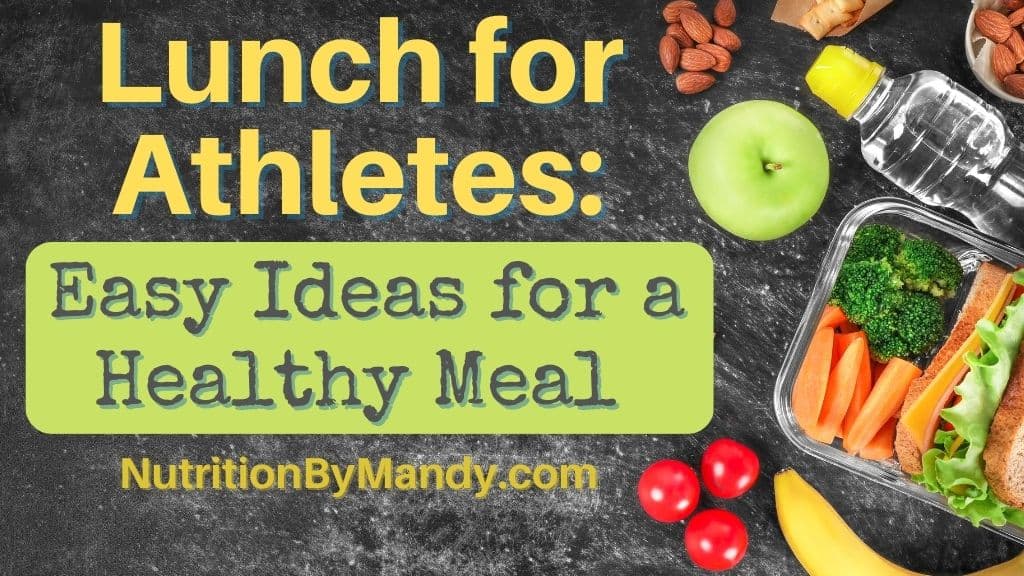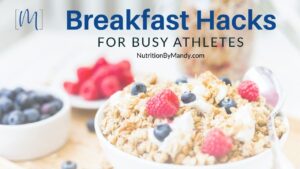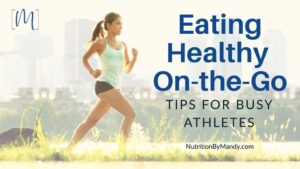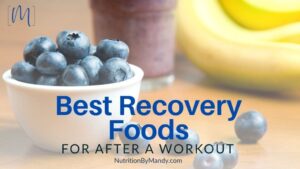Last Updated on December 28, 2023 by Mandy Tyler, M.Ed., RD, CSSD, LD
Lunch for Athletes: Easy Ideas for a Healthy Meal
Making time for lunch is important for athletes. With busy schedules having ideas for building a quick, nutritious meal can be of help.
Let’s take a look at how to plan healthy lunches for athletes to ensure they are fueled to train and perform at their best.
Planning Healthy Lunches for Athletes
When it comes to building a healthy lunch for athletes, planning ahead is important.
Consider taking time on the weekends to meal prep items you can add to your lunches during the week. Having the right foods available at the right times is an essential aspect to sports nutrition success.
Key components of a healthy lunch for athletes include:
- Lean source of protein
- Whole grains
- Fruits and vegetables
- Healthy fats
- Hydration

Set a Lunch Time Reminder
If you find yourself forgetting to stop and eat lunch, consider setting an alarm on your watch or smartphone as a reminder. Too often I find athletes get so busy during the day that they forget to eat lunch.
Setting a lunchtime reminder can help ensure you don’t miss a chance to fuel your body.

Lunch for Athletes: Foundation of Carbohydrates
Carbohydrates should be at the foundation of an athlete’s meal plan. Athletes can get carbohydrates in their diet from a variety of sources, including:
- Grains
- Fruits
- Starchy vegetables
- Beans and legumes
- Milk and yogurt
Athletes should make it a priority to include a good source of carbohydrates in their lunches on days when they have afterschool sports. A high-carb lunch can help provide athletes with energy for their afternoon practices or competitions.
Whole Grains
Athletes should focus on choosing whole grains to enjoy with their meals. Whole grains contain fiber, vitamins, and minerals, making them a healthy part of an athlete’s sports nutrition meal plan.
When selecting whole grain items, read the package to ensure the product is 100% whole grain. As you read the ingredient list, the word “whole” should be listed as the first ingredient in the product, such as whole wheat, whole oat, or whole rye.
Dave’s Killer Bread® has a wide variety of whole grain bread products including sandwich bread, bagels, and buns available.
In addition to bread, athletes can enjoy quinoa, brown rice, and whole grain pasta with their lunch.
Consider preparing a large batch of your favorite rice or pasta on the weekend to have available for lunches throughout the week. You can also purchase individual microwavable packages of quinoa or brown rice to heat and enjoy with your meal.
Lunch for Athletes: Fruits and Vegetables
Fruits and vegetables are an excellent way to add fiber, vitamins, minerals, phytochemicals, and antioxidants to your lunch.
When it comes to fruits and vegetables variety is key. Eating a rainbow of colorful fruits and vegetables will allow you to get a diverse array of nutrients in your overall diet.

Fresh Produce
Fresh fruits and vegetables can make an easy lunch addition, as they require limited preparation and can easily be tossed into your lunch bag on the way out the door.
Items such as apples, bananas, grapes, oranges, baby carrots, celery sticks, cherry tomatoes, cucumber slices, and mini sweet peppers are all great options.
When it comes to fresh produce, make sure to purchase fruits and vegetables that are in-season. Produce that is in-season will be more flavorful and less expensive than produce that is out of season.
The USDA has a Seasonal Produce Guide available to help you determine which fruits and vegetables are currently in season.
Dried and Canned Fruit
Dried fruit is another way to boost your carbohydrate, fiber, vitamin, mineral, and antioxidant intake with lunch (1). In addition to raisins and dried cranberries, consider trying dried pineapple, papaya, and mango with your lunch.
Canned fruit can also be a nutritious addition to an athlete’s lunch. When purchasing canned fruit make sure to select fruit that is packed in natural juices rather than heavy syrup.
Beans and Legumes
Beans and legumes are a great way to boost the carbohydrate, fiber, and protein content of your lunch. Consider adding beans to a burrito bowl, used them as a topping on a salad, or enjoy beans as a side with your meal.

Lunch for Athletes: Include Lean Protein
When you plan your lunch, make sure to include a source of lean protein.
Athletes should aim to consume 20-40 grams of protein (0.25-0.3 grams of protein/kg body weight) with meals and snacks throughout the day (2, 3).
Below are a variety of ideas for lean protein sources to include in your lunch.
Tuna and Salmon
Canned or packaged tuna and salmon provide both lean protein and healthy omega-3 fatty acids.
When selecting tuna, keep in mind that canned white (albacore) tuna tends to be a better source of omega-3s than chunk light tuna.
In addition, choose tuna or salmon that is packed in water rather than oil. When the fish is packed in oil the product will be higher in saturated fat.
Many brands of tuna and salmon now come in convenient single-serving pouches, making them ideal for lunch on-the-go. Enjoy the tuna or salmon as a sandwich spread, topping on whole grain crackers, or high-protein topping on a salad with your meal.
Hard-Boiled Eggs
Hard-boiled eggs can make a great, protein-rich addition to your lunch. However, I find hard-boiled eggs are often an option that is over-looked by athletes.
A large egg contains ~6 grams of protein (4). In addition to protein, eggs contain choline, a nutrient that is important for cognitive function, as well as vitamins, minerals, and antioxidants (2).
If you don’t want to boil the eggs on your own for lunch, you can purchase eggs that have already been hard-boiled at the grocery store.
The premade hard-boiled eggs come peeled and ready-to-eat. So, all you have to do is add them to your lunch bag on the way out the door.
Deli Meat: Convenient Addition to an Athlete’s Lunch
An easy and well-known way of adding protein to your lunch is with deli meat. Whether you enjoy deli meat in a sandwich or sliced with crackers, it is a convenient option for a grab-and-go lunch.
When selecting deli meat choose healthier varieties, such as turkey, chicken, roast beef, and ham. Deli meat such as salami, pepperoni, and bologna tend to be higher in saturated fat and less healthy choices.
When possible, purchase deli meat that is sliced fresh for you at the store.
Chicken Breast
Chicken breast is a lean source of protein, providing ~7 grams of protein per ounce (5). At lunch you can enjoy chicken sliced as a filling in a wrap, in a stir-fry with rice and vegetables, or diced to make chicken salad.
The next time you bake, roast, or grill chicken, make extra to have available for lunches throughout the week.
Greek Yogurt
Greek yogurt is an excellent way for athletes to boost the protein content of their lunch. A 5.3 oz individual container of Greek yogurt contains ~13 grams of protein (6).
In addition to protein, Greek yogurt provides calcium and some varieties are also fortified with Vitamin D.
Plain Greek yogurt is versatile and can be used as a substitute for sour cream in recipes. A personal favorite is making Greek yogurt ranch dip with dry Hidden Valley® Ranch seasoning mix.
Instead of using sour cream, stir the seasoning into plain, unflavored Greek yogurt. This will create a delicious, high-protein dip for your veggies at lunch.
Cheese
Another easy way to boost the protein content of your meal is with cheese. In general, a 1-oz serving of cheese provides ~7 grams of protein along with calcium (7).
If you are selecting a sliced cheese to add to your sandwich, I suggest choosing a reduced-fat cheese made with 2% milk. The reduced-fat version is lower in saturated fat, but contains a similar amount of both protein and calcium.
Cheese sticks are also a great addition to a lunch on-the-go for athletes. Similar to sliced cheese, many brands are starting to offer reduced-fat cheese sticks. In addition, you can now find cheese sticks made with a variety of types of cheese ranging from mozzarella and Colby jack to Havarti and Gouda.
Cottage Cheese: High-Protein Addition to Lunch for Athletes
Finally, don’t forget about cottage cheese when thinking about ways to add protein to your lunch.
Cottage cheese is packed full of protein, containing ~28 grams of protein per cup (depending on the brand). It also contains riboflavin (Vitamin B2) and many brands are fortified with calcium (8).
You can purchase cottage cheese in individual serving size cups, which are convenient for packing into your lunch bag. Try mixing cottage cheese with fruit, such as pineapple or peaches, for a nutritious side with your lunch

Lunch for Athletes: Plant-Based Protein Sources
There are a variety of plant-based protein sources that can make a healthy addition to lunch. Athletes following a vegetarian or vegan diet should ensure they include plant-based sources of protein in their lunch.
Nuts and Nut Butters
Nuts are a great way to add protein, healthy unsaturated fats, vitamins, minerals, and antioxidants to your lunch (1).
Consider packing a variety of nuts to enjoy with your lunch, as different types of nuts provide different nutritional benefits. You can purchase pre-packaged snack size bags of almonds, cashews, or mixed nuts that make a convenient addition to lunch.
Nut butters make a great topping for sandwiches, spread for crackers, or dip for celery or apple slices in your lunch. In general, a 2-tablespoon serving of nut butter contains ~7 grams of protein (9).
When selecting a nut butter, choose a product that has limited added ingredients, such as hydrogenated oil. You can purchase nut butters in individual 1-1.5 oz containers, which are perfect to throw into your lunch bag.
Athletes who have a nut allergy, can consider trying SunButter® products, which are prepared with sunflower seeds and are allergen free.
Hummus
Hummus is a nutritious, plant-based food that makes a delicious spread or dip. It is made with chickpeas and contains carbohydrates, protein, vitamins, and minerals.
Consider adding hummus to your sandwich or wrap, or enjoying it as a dip with pita chips or vegetables. You can purchase hummus in a 2-oz snack size container, which are the perfect size for a vegetable dip.
Soy Protein
Unlike many plant proteins, soy protein is a complete protein. A complete protein contains all nine of the essential amino acids that our bodies cannot produce (6).
Tofu, soy milk, soy yogurt, and edamame are all great options for adding soy protein to your lunch.
Lunch for Athletes: Healthy Fats
Including healthy, unsaturated fats in your lunch is a great way to round out your meal.
Fat is important in the diet of athletes, as it helps your body absorb, transport, and store fat soluble vitamins (Vitamins A, D, E, and K). It also helps provide protection for our internal organs.
In addition, omega-3 fatty acids are necessary for optimal function of the brain and immune system (10).
Healthy fats you can add to your lunch include:
- Nuts and nut butter
- Fatty fish: Tuna and salmon (discussed above), as well as sardines, anchovies, mackerel, and herring.
- Seeds and seed butter: Pumpkin and sesame seeds can make a great addition to wraps, trail mix, or a salad.
- Avocado or guacamole: Add to sandwiches, wraps, burrito bowls, or use as a dip for vegetables or whole grain pita chips.
Lunch for Athletes: Importance of Hydration
Hydration is important for an athlete’s health as well as for sports performance.
Make it a priority to drink fluid with lunch to help you stay on top of your hydration goals. To avoid filling up on the beverage, eat your meal first and then consume your beverage.
In addition to water, consider enjoying the following beverages with your lunch:
- Low-fat milk
- 100% fruit or vegetable juice
- Sparkling water
- Infused water
Pro Tip: You can flavor your water by simply adding fresh berries, a few slices of cucumber, a wedge of lemon or lime, or mint to your water. Try adding this to your refillable water bottle at the start of the day and enjoy flavored water all day long.
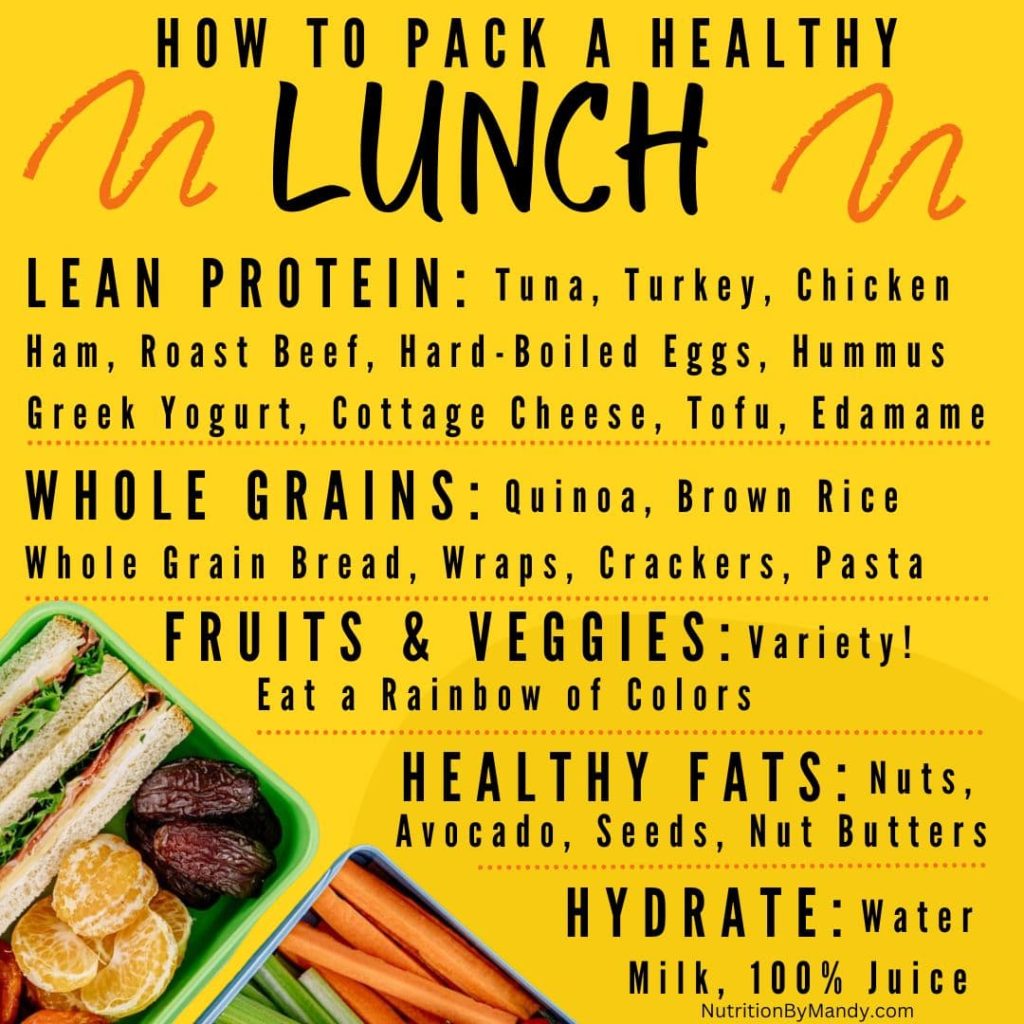
Ready to Pack Your Lunch
You are now set with ideas for building a healthy lunch for athletes. By planning ahead, you can ensure that you pack a lunch that will keep you fueled for afternoon activities.
If you are looking for additional sports nutrition lunch tips, check out my blog: 10 Whataburger Healthy Options for Athletes.
Join the Nutrition By Mandy Email List & Get a Free Athlete’s Grocery List
Click HERE to join the Nutrition By Mandy e-mail list. When you join you will receive a free athlete’s grocery list to print and take with you to the store.
About the Author
Mandy Tyler is a Sports Dietitian Nutritionist in the San Antonio, TX area. She is a Registered and Licensed Dietitian, a Board-Certified Specialist in Sports Dietetics, a Licensed Athletic Trainer, and is a Certified Exercise Physiologist through the American College of Sports Medicine. Mandy has experience working with athletes at the high school, collegiate, and professional levels. She believes the key to reaching one’s full potential, both in everyday life and in sports performance, relies on a healthy nutritional foundation.

